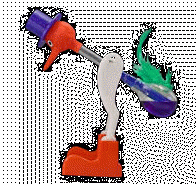|
Energy & Power I
Objectives
• Know that power is measured in units of Watts
• Be able to calculate the power of a human, based on
information about the work done and the time taken.
Task 1 - Recap
Remind the person next to you:
• The units used to measure efficiency
• What is meant by "an efficient device"
• What is meant by "an inefficient device"
Task 2
Discuss what you think the word power
means.
Where have you heard the term power
used?
Power is measured in units called "Watts"
- try think of anywhere you might have seen a power rating written on an
appliance before.
Task 3
We are going to measure our own power outputs - how
powerful we are. We will do this by doing some work (using
energy), and timing how long it takes.
We will do some work in one of the following ways:
1. running up a flight of
stairs
or
2. climbing up and down
onto a stool 10 times.
Your teacher will tell you
which method to use. Complete your results in the first row of the table
you have been given.
n.b. ready made results
tables are available for both the
stair-climbing practical task, and for the
stool-jump practical task.
Task 4
Collect the weights and times for 9 other people and
fill these in on your table, then complete the table by calculating the
work each person has done and how powerful they are.
You will need to use the following formulae:
|
W =
F × d
|
W =
Work done, measured in Joules (J)
F = force, measured
in Newtons (N)
d = distance, measured in metres
(m) |
and
|
P =
E ÷ t
|
P =
Power, measured in Watts (W)
E = Energy
transferred, measured
in Joules (J)
t = time taken,
measured in seconds (s) |
Task 5 - Extension
Answer the questions below:
1. Who are the three most powerful people in the room
in order?
2. How many 40W lightbulbs could you power?
3. How many 11W "energy efficient" lightbulbs could
you power?
4. A horse can produce a peak power of 750W. How many
students would need to work together to be as powerful as a horse?
5. A particular car has a power rating of
150horsepower. How many Watts is this?
Watts and horsepower are not the only units we could
use to measure power - look at this graph showing the
power output of different animals!
Homework
Find the power rating of at least 8 appliances from
around your home and estimate the amount of time each one is switched on
during a typical day.
[Teacher
note: make a
ready made results table for this task and link it in here.]
|

